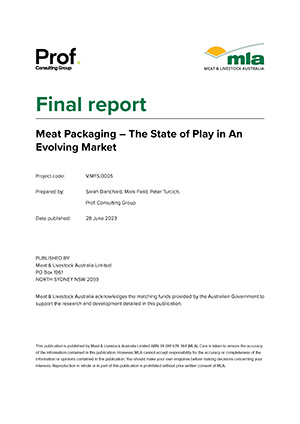 Voluntary commitments to national targets, compliance with legislation or reducing the risk from packaging tax are rapidly becoming barriers to trade in markets relying on packaged products.
Voluntary commitments to national targets, compliance with legislation or reducing the risk from packaging tax are rapidly becoming barriers to trade in markets relying on packaged products.
Increasingly rigorous sustainability requirements from key customers, timebound commitments, and legislation are presenting a risk to domestic and international trade of packed red meat products.
The ability of businesses and brand owners to respond to these concerns is a key aspect to achieve long-term sustainable growth. As a major contributor to the Australian economy, it is critical to maintain the industry-leading brand position of Australian red meat and its clean, green, and safe image.
Objectives
This project was tasked with identifying the packaging materials at risk in the Australian market and to provide an unbiased baseline evaluation to support innovation and progression towards the future of sustainable meat packaging.
Key findings
- Good progress towards achieving APCO sustainability guidelines for red meat packaging. Retailers’ sustainability commitments for packaging based on APCO targets of 2025.
- Food industry overall not expected to meet APCO targets, and will likely lead to introduction of Extended Producer Responsibility Regulations by 2025.
- Most rigid and plastic components surveyed complied with APCO guidelines: 75% in our sample of rigid plastic formats and 70% of soft plastic components complied. However only 20% of packaging accessories complied with APCO.
- Plastic red meat packaging has been reduced, fibre-based materials are more established and problematic packaging (containing chemicals harmful to the environment and black packaging) are very limited on shelf. Packaging accessories (such as bone guards, netting etc) continue to be unrecyclable although progress is being made to convert paper labels to plastic which is better for recycling.
- Packaging with reduced petrochemical based plastic alternatives are on shelf, however complete elimination of plastic remains unfeasible under the current consumption model which requires a robust shelf-life performance. Reusable containers have not made a mark on the domestic market.
- For continued use of plastic to be sustainable, it requires a complete system to collect and reprocess it into materials that can be used again for food packaging. While recycling of rigid plastic red meat packaging via kerbside collection has been successful, processing of plastic into food grade material (advanced or chemical recycling) is not happening at the required scale. Without this capability, the Australian plastics economy does not benefit from full circularity and red meat risks economic penalties when EPR is introduced.
Benefits to industry
Sustainable packaging helps processors to comply with national commitments, gain consumer trust, contribute to the reputation of red meat brands and to be ready for likely developments in regulations such as plastic taxes.
An updated guide to choosing sustainable packaging components can be adopted by the industry to make better decisions in packaging.
A future path with upcoming developments in the packaging ecosystem (machinery, advanced recycling, data transparency) shows how the industry is moving towards a circular economy and where collaboration between different stakeholders across the value chain brings benefits and minimises risks from impending regulation and customer requirements.
With a sharpened global focus on plastic pollution and greenhouse gas emissions, driven by the UN Plastic Treaty and Paris Agreement respectively, the report shows how sustainable red meat packaging can contribute to reducing plastics pollution, greenhouse gas emissions, and food waste.
